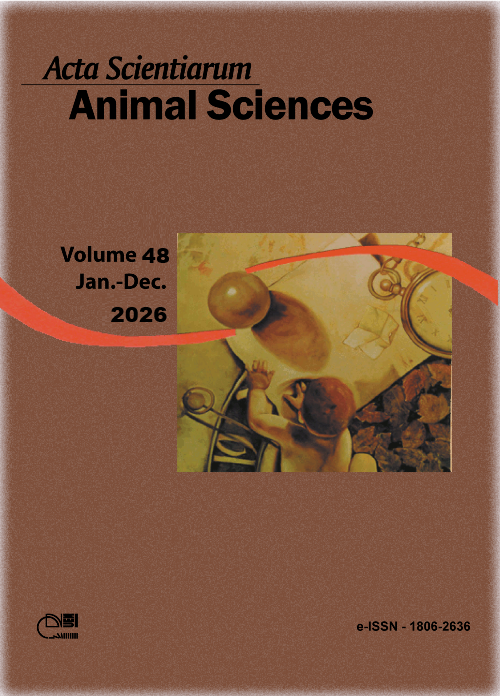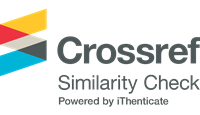Variables with greater discriminatory power for adaptation based on multivariate analysis
Abstract
The objective of this research is to evaluate the physiological variables altogether and determine which variables have the greatest power to explain the data variation in terms of adaptive profile, using canonical and stepwise discriminant analysis. Eighteen non-castrated male sheep of the Soinga, Morada Nova, and Santa Inês breeds were used, with an average age of 5±1.0 months and an average weight of 15 ± 2.3 Kg. The RT showed a significant correlation above 50% with the temperature of the scrotum and leg; RR showed a higher correlation with tympanic (69%) than with RT (53%) tympanic showed a correlation above 70% with the temperature of the chest, back, buttocks, testicles, and leg, and 63% with the temperature of the eye, while RT showed a correlation of less than 50% with the temperature of the chest, buttocks, back and eye, and 51% with the testicle and leg. The most discriminatory variables for native breeds at comfort temperatures and thermal stress were reat rate and tympanic temperature. Tympanic temperature proved to be an important physiological variable to aid in the study of the adaptive profile of animals.
Downloads
References
Boere, V., & Mazzotti, G. A. (2009). Comparação entre temperatura retal e temperatura da membrana timpânica em gatos (Felis catus) normotérmicos. Ciência Animal Brasileira, 10(3), 961-966.
Correa, M. P. C., Dallago, B. S. L., Paiva, S. R., Canozzi, M. E. A., Louvandini, H., Barcellos, J. J., & McManus, C. (2013). Multivariate analysis of heat tolerance characteristics in santa inês and crossbred lambs in the Federal District of Brazil. Tropical Animal Health and Production, 45, 1407-1414. https://doi.org/10.1007/s11250-013-0378-3
De Maesschalck, R., Jouan-Rimbaud, D., & Massart, D.L. (2000). The Mahalanobis distance. Chemometrics and Intelligent Laboratory Systems, 50(1), 1-18. https://doi.org/10.1016/S0169-7439(99)00047-7
Dillon, W. R., & Goldstein, M. (1984). Multivariate analysis: methods and applications. John Wiley.
Dossa, L. H., Wollny, C., & Gauly, M. (2007). Spatial Variation in goat populations from Benin as revealed by multivariate analysis of morphological traits. Small Ruminant Research, 73(1-3), 150-159. https://doi.org/10.1016/j.smallrumres.2007.01.003
Ferreira, A. C. H., Neiva, J. N. M., Rodriguez, N. M., Campos, W. E., & Borges, I. (2009). Avaliacão nutricional do subproduto da agroindústria de abacaxi como aditivo de silagem de capim-elefante. Revista Brasileira de Zootecnia, 38(2), 223-229. https://doi.org/10.1590/S1516-35982009000200002
Gois, G. C., Campos, F. S., Carneiro, G. G., Silva, T. S., & Matias, A. G. S. (2017). Estratégias de alimentação para caprinos e ovinos no semiárido brasileiro. Nutri Time, 14(4), 7001-7007.
Greenes, D. S., & Fleischer, G. R. (2004). When body temperature changes, does rectal temperature lag?. Journal of Pediatric, 144(6), 824-826. https://doi.org/10.1016/j.jpeds.2004.02.037
Guedes, D. G. P., Ribeiro, M. N., & Carvalho, F. F. R. (2018). Multivariate techniques in the analysis of carcass traits of Morada Nova breed sheep. Ciência Rural, 48(9), e20170746. https://doi.org/10.1590/0103-8478cr20170746
Kunkle, G. A., Nicklin, C. F., & Sullivan-Tamboe, D. L. (2004). Comparison of body temperature in cats using veterinary infrared thermometer and a digital rectal thermometer. Journal of the American Animal Hospital Association, 40(1), 42-46. https://doi.org/10.5326/0400042
Landim, A. V., Roriz, N. D., & Silveira, R. M. F. (2021). Sheep meat production in the Brazilian semi-arid region: crossing between indigenous breeds. Tropical Animal Health and Production, 53, 510. https://doi.org/10.1007/s11250-021-02947-1
Michaud, A. J. (1996). Comparison of an infrared ear thermometer to rectal thermometers in cats. Feline Practice, 24(6), 25-30.
Ribeiro, N. L., Pimenta Filho, E. C., Arandas, J. K. G., Ribeiro, M. N., Saraiva, E. P., Bozzi, R., & Costa, R. G. (2015). Multivariate characterization of the adaptive profile in brazilian and italian goat population. Small Ruminant Research, 123(2-3), 232-237. https://doi.org/10.1016/j.smallrumres.2014.12.010
Schmidt-Nielsen, K. (1997). Animal physiology: adaptation and environment. Cambridge University Press.
Silveira, R. M. F., McManus, C. M., Carrara, E. R., DeVecchi, L. B., Carvalho, J. R. S., Costa, H. H. A., Pilonetto, F, Fávero, L. P. L., & Landim, A. V. (2024). Adaptive, morphometric and productive responses of Brazilian hair lambs: crossing between indigenous breeds - a machine learning approach. Small Ruminant Research, 232, 107208. https://doi.org/10.1016/j.smallrumres.2024.107208
Simões, A. L. B., Martino, M. M. F. (2007). Variabilidade circadiana da temperatura oral, timpânica e axilar em adultos hospitalizados. Revista da Escola de Enfermagem da USP, 41(3), 485-491. https://doi.org/10.1590/S0080-62342007000300020
Starling, J. M. C., Silva, R. G., Ceron-Munhoz, M., Barbosa, G. S. S. C., Paranhos, M. J. R., (2002). Análise de algumas variáveis fisiológicas para avaliacão do grau de adaptacão de ovinos submetidos ao estresse por calor. Revista Brasileira de Zootecnia, 31(5), 2070-2077. https://doi.org/10.1590/S1516-35982002000800022
Tadesse, D., Patra, A. K., Puchala, R., Hussein, A., & Goetsch, A. G. (2023). Differentiation of hair sheep breeds based on the physiological and blood biochemical changes in response to different stressors using multivariate analysis techniques. Animals, 13(16), 2643. https://doi.org/10.3390/ani13162643
Zepeda, H. J. S., Guerra, F. F. J., Garcia, M. H., Serrano, E. R., Vázquez, A. C. ., Cruz, A. B., & Bermejo, J. V. D. (2002). Estudio de los recursos genéticosde México: características morfológicas y morfoestructurales de loscaprinos nativos de Puebla. Archivos de Zootecnia, 51, 53-64.
Copyright (c) 2026 Neila Lidiany Ribeiro, Dermeval Araujo Furtado, Ricardo Sousa Silva, Raimundo Calixto Martins Rodrigues, Airton Gonçalves Oliveira , Nagela Maria Henrique Mascarenhas, Tacila Rodrigues Arruda, Fabiana Teresinha Leal de Morais

This work is licensed under a Creative Commons Attribution 4.0 International License.
DECLARATION OF ORIGINALITY AND COPYRIGHTS
- I Declare that current article is original and has not been submitted for publication, in part or in whole, to any other national or international journal.
The copyrights belong exclusively to the authors. Published content is licensed under Creative Commons Attribution 4.0 (CC BY 4.0) guidelines, which allows sharing (copy and distribution of the material in any medium or format) and adaptation (remix, transform, and build upon the material) for any purpose, even commercially, under the terms of attribution.
Read this link for further information on how to use CC BY 4.0 properly.








































